Chapter 2 The 2030 Agenda for Sustainable Development
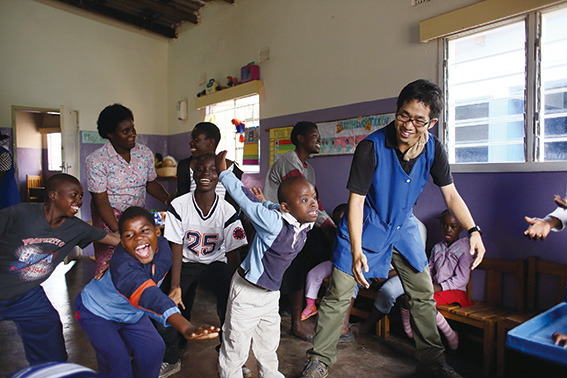
A Japan Overseas Cooperation Volunteer (disability aid provider), Mr. Yusuke Yoshizawa teaches dancing to children at the Little Assisi Special School in Zambia. (Photo: Atsushi Shibuya / JICA)
Section 1 Efforts Leading up to the 2030 Agenda for Sustainable Development
The UN Summit on the MDGs, held at the UN in September 2010, served as a forum for world leaders to discuss the post-2015 development agenda, i.e., the goals that would succeed the MDGs after 2015. The global discussions regarding the post-2015 development agenda swung into full gear by way of the ministerial-level MDGs Follow-up Meeting that Japan co-organized with the United Nations Development Programme (UNDP), the World Bank, and other partners in June of the following year (2011), and an informal ministerial-level meeting on the MDGs held on the margins of the UN General Assembly session in September of the same year. The work of arriving at the agenda proceeded through notably the following three processes (see Figure 1).
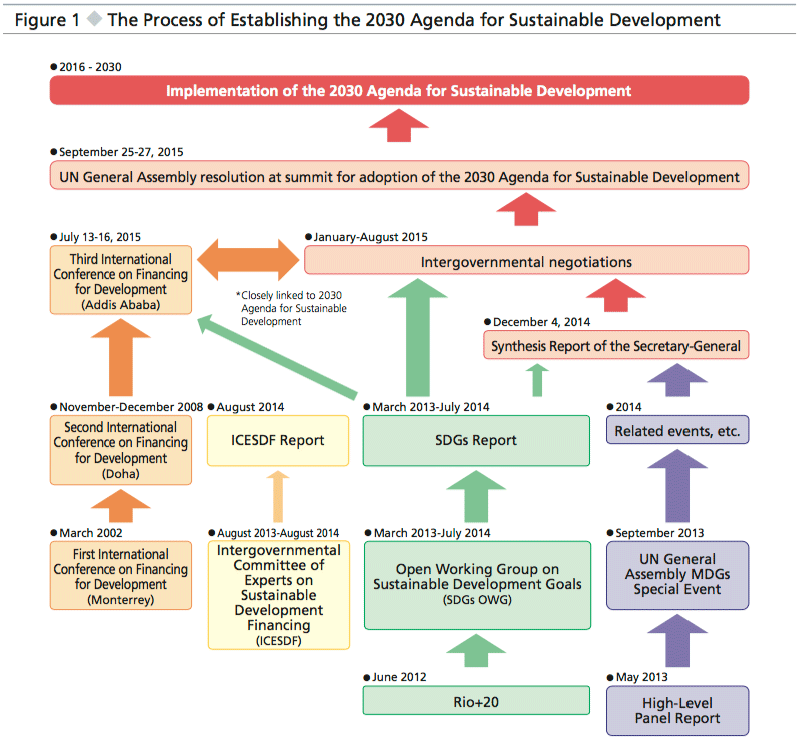
Process led by the UN Secretary-General
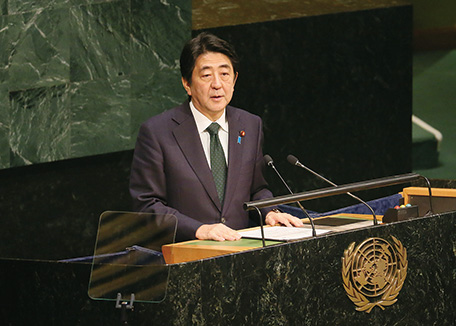
Prime Minister of Japan Shinzo Abe announces Japan’s initiatives to promote the 2030 Agenda for Sustainable Development at the UN Sustainable Development Summit held in September 2015. (Photo: Cabinet Public Relations Office)
At the UN, discussions on the post-2015 development agenda began at a High-Level Panel launched by Secretary-General Ban Ki-moon in July 2012 consisting of 27 eminent persons. In May 2013, the High-Level Panel submitted a report to Secretary-General Ban proposing post-2015 goals comprised of 12 goals and 54 targets.
Thereafter, Secretary-General Ban continued to host a series of fora at which timeframes were determined for the subsequent intergovernmental negotiations and adoption, including the Special Event towards Achieving the MDGs held on the sidelines of the UN General Assembly session in September 2013 and the thematic debates and high-level events held in 2014.
Process of the UN Conference on Sustainable Development (Rio+20)
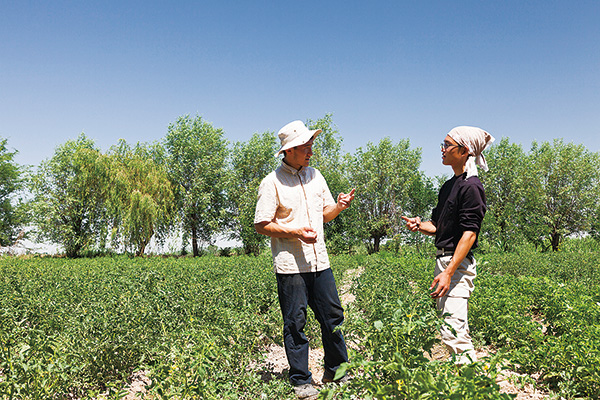
A JICA team member, Mr. Tomohiro Honda visits an organic onion field at a pilot farm near Bishkek in the Chuy Province, the Kyrgyz Republic. (Photo: Kaku Suzuki / JICA)
The approach to sustainable development had been discussed from before at the UN in various fora, including the Earth Summit (UN Conference on Environment and Development) held in Rio, Brazil in 1992.
As part of this effort, it was decided at the UN Conference on Sustainable Development (Rio+20) in June 2012 that Sustainable Development Goals (SDGs) would be created, and that these goals would be integrated into the post-2015 development agenda.
Based on this decision, the intergovernmental Open Working Group on Sustainable Development Goals (SDGs OWG) was established, and in July 2014, following negotiations held among nearly all UN member states, SDGs OWG proposed SDGs consisting of 17 goals and 169 targets.
These proposed SDGs were basically incorporated into the post-2015 development agenda (the 2030 Agenda for Sustainable Development adopted at the UN Summit in September 2015).
Development financing process
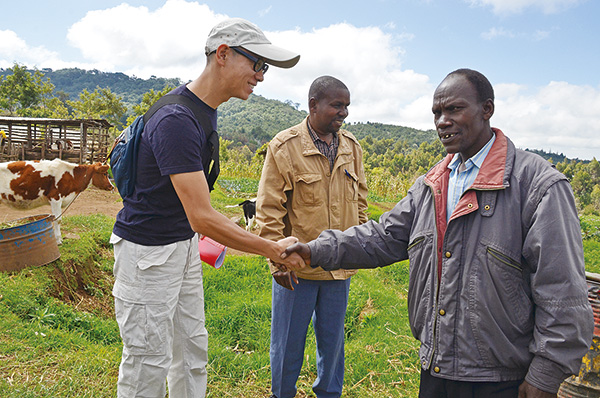
A JICA Expert, Mr. Mitsuhiro Kato greets a group of model farmers in Kijabe, Kenya. (Photo: Takeshi Kuno / JICA)
In the process of considering the post-2015 development agenda, important items for consideration were not only development goals and targets, but also securing and utilizing the financing necessary for achieving these goals and targets. It was primarily the UN-led International Conference on Financing for Development process. Under this process, discussions have taken place regarding financing for development agenda, including the MDGs, through the first conference in Monterrey, Mexico in 2002 and the second conference in Doha, Qatar in 2008. In the lead-up to the third conference in Addis Ababa, Ethiopia in July 2015, this matter was studied among the countries with a focus on development financing for the post-2015 development agenda. In addition, the issue of financing for the post-2015 development agenda was discussed at the Intergovernmental Committee of Experts on Sustainable Development Financing launched in response to Rio+20 held in 2012.
Taking into account these processes, UN member states commenced formal intergovernmental negotiations regarding the post-2015 development agenda in January 2015, as well as the goals and targets and their indicators to be incorporated into the agenda. In the course of seven rounds of negotiations, 193 UN member states exchanged their views concerning the basic concept, goals, means of implementation, follow-up, and more. In this process, dialogues were also carried out with private companies and representatives of civil society. Following this process, the countries agreed on the draft 2030 Agenda for Sustainable Development on August 2, 2015, Japan time, the final day of the seventh round of the negotiations. World leaders formally adopted the 2030 Agenda for Sustainable Development at the UN Summit held from September 25 to 27. Prior to this, in July 2015, the Addis Ababa Action Agenda pertaining to development financing for the post-2015 development agenda was adopted at the Third International Conference on Financing for Development held in Ethiopia.
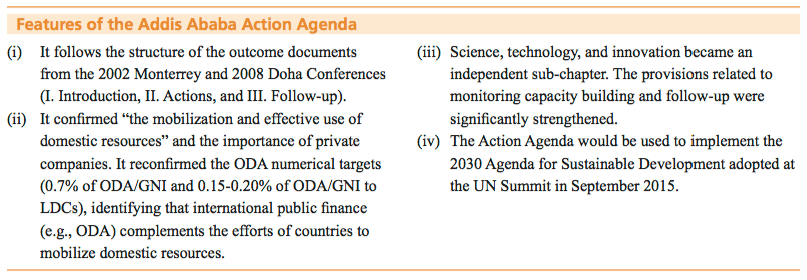
A comparison of the processes of arriving at the MDGs and the 2030 Agenda for Sustainable Development reveals that in contrast with the MDGs that were established by a process led by UN experts, the latter involved diverse processes and proceeded with the involvement of diverse stakeholders, including UN member states, international organizations, private companies, and civil society. This was a suitable process for establishing the 2030 Agenda for Sustainable Development which espouses a commitment to global partnership, with participation from both developing and developed countries and the involvement of diverse stakeholders.
Japan has been proactively engaged in the process of establishing the new development agenda based on the following concept: (i) Build upon the experience and lessons learned from the MDGs; (ii) Give attention to the issues of regional and intra-country disparities and ensure that the vulnerable are not left behind; (iii) Sufficiently shine a spotlight on growth and employment, the sources of wealth creation; (iv) Adapt to changes in the international community; and (v) Promote ownership by developing countries. Accordingly, Japan has been committed to contributing to the progress of the international efforts while explaining Japan’s views through holding various events, namely, the MDGs Follow-up Meeting in June 2011 that was referred to earlier, an informal policy dialogue pertaining to the post-2015 development agenda launched in December 2011 (Contact Group), and related events held on the margins of the UN General Assembly session and the Tokyo Annual Meetings of the International Monetary Fund and the World Bank (2012).

Ground breaking ceremony of the Project for Water Supply in Karadolo West held at Milambo Primary School in Siaya County in the western part of Kenya. (Photo: Kumiko Shibaoka / Embassy of Japan in Kenya)
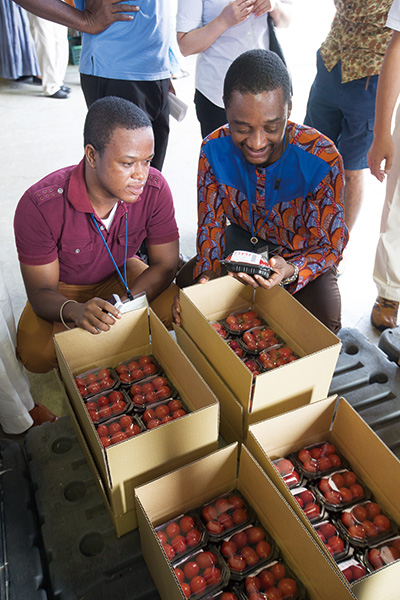
Trainees from Ghana visiting Japan for training on rice harvesting technologies observe procedures for shipment of cherry tomatoes at a warehouse of JA Ogata-mura in Akita Prefecture. (Photo: Shinichi Kuno / JICA)
